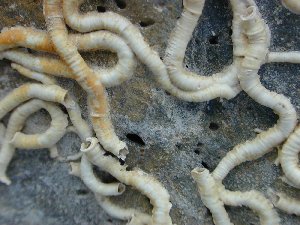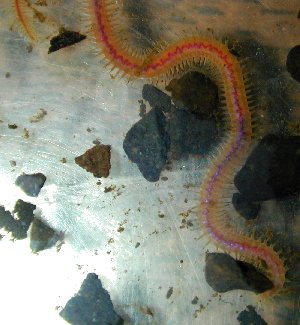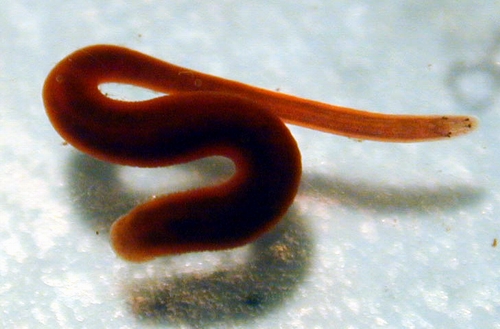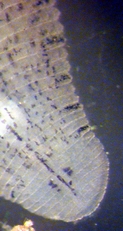|
Key to Segmented Worms
|
|
|
Phylum ANNELIDASegmented worms

Three subclasses of annelids have known representatives in fresh and brackish waters in Hawai‘i: Hirudinea, Oligochaeta, and Polychaeta. These are small, worm-like animals (most under 1 cm) which live a cryptic (hidden) or infaunal (buried in soft sediment) existence. However, oligochates (aquatic earthworms) are readily observed by microscopic examination of submerged vegetation and leaf litter from most aquatic environments, and infaunal oligochaetes and polychaetes dominate estuarine sediments. Calcareous tubes of serpulid worms (see left) can be found attached to hard surfaces in some estuarine or brackish waters. Leeches (Hirudinea) inhabit many streams and estuaries, hiding under rocks or attached to prey (such as fishes). A listing of Hawaiian aquatic annelid worms, including references to useful identification materials, is provided elsewhere in CPIE.
|
|
|
|
[SEGMENTED WORMS]
|
|
|
|
35a
|
(21) |
 Most segments with paired, lateral projections (parapodia) associated with clumps of setae (very fine, projecting structures shaped like needles, hooks, combs, or blades)
Most segments with paired, lateral projections (parapodia) associated with clumps of setae (very fine, projecting structures shaped like needles, hooks, combs, or blades)~ Subclass POLYCHAETA
Polychaete worm
Figure A3-2. Freshwater polychaet, Namalycastis abiuma.
|
|
|
35b
|
|
At most only a few segments at or near the head or tail ends with lateral projections or appendages. Setae present or absent
~ Subclasses OLIGOCHAETA and HIRUDINEA
|
[36]
|
|
|
|
~~~~~~~~~~~~~~~~~~~~~~~~~~~~~
|
|
|
[NOTE THREE CHOICES HERE]
|
|
|
|
36a
|
(35) |
Small (usually under 1-2 cm), red worms living in tubes of mud at bottom of stagnant pools; when alive, whipping back and forth. Tubificid worm
~ Subclass OLIGOCHAETA ~ Family NAIDIDAE (TUBIFICIDAE)
|
|
|
36b
|
|
Animal has attachment discs ("suckers") at front and rear ends of body, the rear disc much larger than the mouth disc (Fig. A3). Leeches ~ Subclass HIRUDINEA
|
|
|
 
Leeches
Figure A3-3a. Note rear attachment disc at bottom left; this deep red species has three pairs of eyes on the head (at right; look closely). Figure A3-3b. Segmented body clearly evident in this mostly colorless leech in the Family Glossiphonidae, also with three pairs of eyespots.
|
|
36c
|
|
Animal is a worm, but not as above
~ other ANNELIDA
|
[88]
|
|